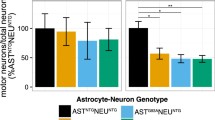Abstract
Defining the basis of the selective cell vulnerability of motor neurones (MN) represents the key issue in amyotrophic lateral sclerosis (ALS), and tissue culture models are the ideal system for the identification of the MN specific features at the single cell level. Neurone-astrocyte metabolic interactions, which have a critical role in MN through glutamatergic toxicity, have been mostly defined in vitro. Ca++ metabolism, which appears to play a critical role in inducing MN loss in ALS, has been successfully studied using in vitro cell models. Furthermore, primary cultures demonstrated that apoptotic or necrotic death of neurones after injury depends upon the cell energetic status. Superoxide dismutase-1 (SOD-1) mutations were successfully expressed in cultured rodent MNs, providing a critical assay to sequence the molecular processes responsible for MN degeneration due to the identified genetic defect. The recent identification of genes that separate humans from apes further increases the value of the human in vitro models to better understand specific human cellular properties. Purified human MNs and astrocytes can today be obtained from the human embryonic spinal cord anterior horns. Interactions at the single cell level can be dissected using the cDNA amplification techniques. The effects of molecules affecting MN survival, neurite extension, and metabolism can easily be defined in vitro, gaining a critical mass of information of immediate clinical application in the treatment of patients affected by ALS. Understanding the properties of human MNs in vitro represents today a significant and critical tool that can easily be reached after extension of the available knowledge from non-primate to human research. Human MN culture studies can greatly contribute to identifying the primitive critical cellular events responsible for the MN degeneration observed in ALS and to gaining crucial information ¶on new therapeutical agents.
Similar content being viewed by others
Author information
Authors and Affiliations
Rights and permissions
About this article
Cite this article
Silani, V., Braga, M., Ciammola, A. et al. Motor neurones in culture as a model to study ALS. J Neurol 247 (Suppl 1), I28–I36 (2000). https://doi.org/10.1007/s004150050554
Issue Date:
DOI: https://doi.org/10.1007/s004150050554




